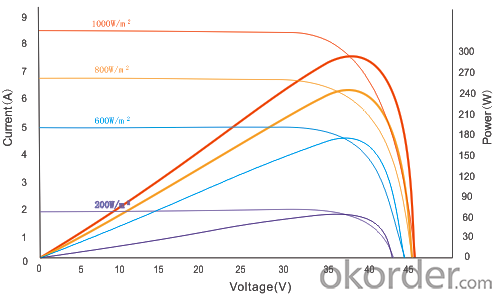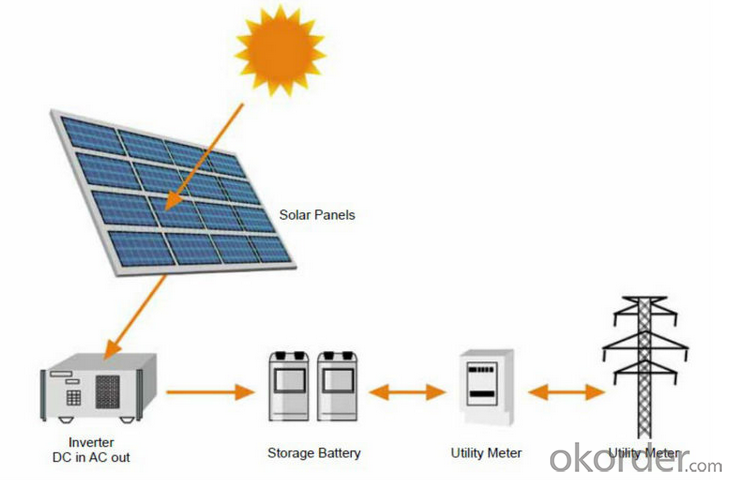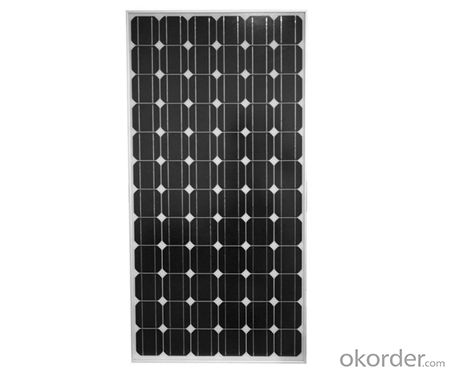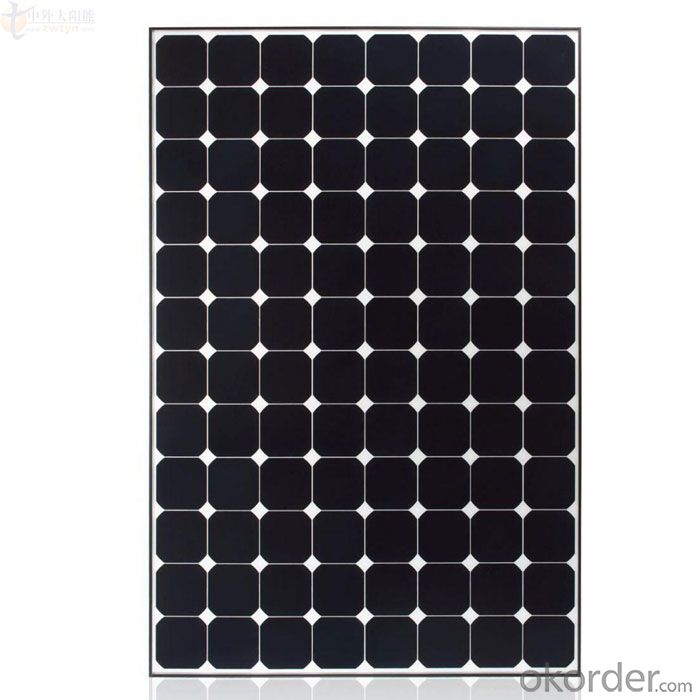260W CNBM Solar Monocrystalline Series (250W—270W)
- Loading Port:
- China main port
- Payment Terms:
- TT OR LC
- Min Order Qty:
- 10000 watt
- Supply Capability:
- 500000 watt/month
OKorder Service Pledge
OKorder Financial Service
You Might Also Like
Item specifice
CNBM Solar Monocrystalline Series III (250W—260W)
Characteristics
Max Power Voltage Vmp(V) | 30.1 | 30.2 | 30.4 | ||
Max Power Current Imp(A) | 8.32 | 8.44 | 8.55 | ||
Open Circuit Voltage Voc(V) | 37.5 | 37.6 | 37.7 | ||
Short Circuit Current Isc(A) | 8.87 | 8.99 | 9.10 | ||
Max Power Pm(W) | 250 | 255 | 260/265 | ||
Temperature Coefficient of Cells
NOCT | 45℃±2℃ | |
Temperature Coefficients of Isc (%/℃) | - 0.0492 | |
Temperature Coefficients of Voc (%/℃) | – 0.3374 | |
Temperature Coefficients of Pmp (%/℃) | –0.4677 | |
Mechanical Data
Dimension | 1638 x 982 x 40 mm | |
Weight | 19.5kg | |
No. of Cells and Connections | 60 (6 x 10) | |
Tolerance | 0~+5W | |
Cell Monocrystalline Cell | 156 x 156 mm | |
Packing | 700 Pcs/40ft(H) Container |
Limits
Operating Temperature | –40 °C to +85°C | |
Storage Temperature | –40 °C to +85°C | |
Max System Voltage | 1000VDC(IEC) / 600VDC(UL) | |
IV Curve



Image


Guarantees
Products Guarantee 12 yrs free from defects in materials and workmanship
Performance Guarantee No less than 90% within 10yrs and no less than 80% within 25yrs
Certificates TUV (IEC61215&IEC61730), VDE(IEC61215&IEC61730), UL, CE
FAQ
1. Q: Do you have your own factory?
A: Yes, we have. Our factory located in Jiangsu province.
2. Q: How can I visit your factory?
A: Before you take off from your country, please let us know. We will show you the way, or arrange time to pick you up if possible.
3. Q: Do you provide free sample?
A: Usually we do not offer free sample
4. Q: Could you print our company LOGO on the nameplate and package?
A: Yes, we can do that.
- Q:I've heard that solar panels have back-up batteries for when it is cloudy or rainy that day.. is this true?
- There okorder / Why pay thousands of dollars for solar energy ($27,000 average cost) when you can build your own solar panel system for just a fraction of the retail cost. You can build a single solar panel or you can build an entire array of panels to power your whole house. Some people are saving 50% on their power bill, some people are reducing their bill to nothing. But what’s most impressive is that just by following these instructions some are even making the power company pay them!
- Q:If i took a lazier pointer and aimed it a solar panel would it take in the light. Also what types of lights would work on a solar panel like L.E.D, uv light bulbs.
- a million. Do they scratch actually? No How do I eliminate snow from them without scratching them? purely wipe the snow off 2. What does the maintenance of many image voltaic panels contain? sparkling them with faucet water and paper towels as quickly as a month. 3. Are all image voltaic panels created from the comparable fabric, regardless of length? extremely the comparable.
- Q:discription how does solar panels save energy
- Solar panels don't save energy, they just utilize a different source of energy. To the extent that it replaces energy from sources which are limited themselves (such as fossil fuels), solar energy does save those resources.* The main benefits of solar energy are environmental in the sense that it is nonpolluting,* but using solar energy doesn't reduce actual power consumption. *Excludes environmental costs of producing the solar panels themselves, but these are much smaller than the environmental benefits of solar vs. fossil fuel (which has infrastructure costs of its own).
- Q:How can solar panels be integrated into building designs?
- Solar panels can be integrated into building designs by incorporating them into the roof or facade of the building. This involves installing solar panels in a way that seamlessly blends with the architecture while maximizing exposure to sunlight. Additionally, solar panels can also be integrated into shading devices, windows, or canopies to generate electricity while providing additional functions such as shading or daylighting.
- Q:Someone Said It costed them 50,000 To Install Solar Panel In their House and 35,000 For Installation. Is that true?
- Are they saying that the panels cost $5k and the installation cost $35k? Or are they saying the panels were $50k, plus another $35k for installation, making the total $85k? Possibly the data was from several years ago. $5k buys 6 kW of panels today, larger than goes on most houses. Installation depends on local labor costs, but should not be more than about $5k in the US, unless the system is huge, or unusual, such as a standalone system on a concrete pad, instead of just on the roof. The system on our roof is roughly 3 kilowatts. If installed today, the parts would cost about $9k. After federal tax credit, $7k. Labor depends on the local situation. We installed our own, so didn't pay any labor cost.
- Q:Can solar panels be used for street lighting?
- Yes, solar panels can be used for street lighting. Solar panels can generate electricity from sunlight and store it in batteries, which can then power streetlights during the night. This is an eco-friendly and cost-effective solution for street lighting, as it reduces reliance on the electrical grid and helps to conserve energy.
- Q:Can solar panels work in cloudy weather?
- Yes, solar panels can still generate electricity in cloudy weather. While their efficiency may be slightly reduced, they can still convert sunlight into usable energy even when the sun is not fully visible.
- Q:If you need 9400 watts, 75 amps@ 240V, how many solar PV panels do you need?
- 75 amps @ 240VDC is 8,000 watts.
- Q:How much space is required for installing solar panels?
- The amount of space required for installing solar panels depends on various factors such as the type and size of the panels, the energy needs of the property, and the efficiency of the panels. Generally, for residential installations, it is recommended to have around 100-400 square feet of roof space per kilowatt of solar panels. However, ground-mounted systems may require larger areas depending on the number of panels and their tilt angles. It is advisable to consult with a solar installer or expert to determine the exact space requirements for a specific project.
- Q:We have LED at the output of 40 watts and is used for 0 hours giving us 400 Watts-hr of energy consumed.Rechargable batteries needed are 2 V. 400/2 gives us 34 Ampere-hour battery needed. If we want it for 3 days, It would be 34x3=00 Ah. So the battery needed 00 AhNow how do I select the solar panel which can charge this/these batteries? What should be its rating?
- First, you need to make sure that your battery can take a regular 34Ah discharge without damage. The usual wisdom when using deep cycle lead-acid batteries is to allow for no greater than 50% discharge. This is to prevent the battery from ageing prematurely. Note that automotive batteries are not usually considered suitable for deep-cycle applications. Best allow for at least 200Ah capacity. Your solar panel capacity needs to take into account that whatever the nameplate output of the panel, that will be what it will produce under ideal conditions, actual output will always be less, often quite a bit less. You also need to allow capacity to cope with dull, overcast days when the light level is very low. You can get solar maps that will give you the sunshine hours and irradiation levels at your location. The solar panel capacity ends up being a juggling act between available funds/space and how critical it is that the light always works as desired. Let's say you had a 400W panel, which sounds quite generous. In the middle of winter, it may produce only 75W for 5 hours on a dull day, not quite enough to run the light for 0 hours. Would you expect several such days in a row? How many days could a 00Ah of battery capacity cover under these conditions?
1. Manufacturer Overview |
|
|---|---|
| Location | |
| Year Established | |
| Annual Output Value | |
| Main Markets | |
| Company Certifications | |
2. Manufacturer Certificates |
|
|---|---|
| a) Certification Name | |
| Range | |
| Reference | |
| Validity Period | |
3. Manufacturer Capability |
|
|---|---|
| a)Trade Capacity | |
| Nearest Port | |
| Export Percentage | |
| No.of Employees in Trade Department | |
| Language Spoken: | |
| b)Factory Information | |
| Factory Size: | |
| No. of Production Lines | |
| Contract Manufacturing | |
| Product Price Range | |
Send your message to us
260W CNBM Solar Monocrystalline Series (250W—270W)
- Loading Port:
- China main port
- Payment Terms:
- TT OR LC
- Min Order Qty:
- 10000 watt
- Supply Capability:
- 500000 watt/month
OKorder Service Pledge
OKorder Financial Service
Similar products
New products
Hot products




























